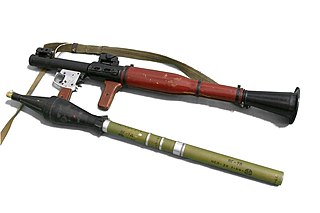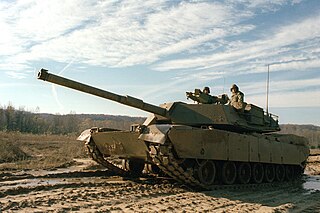
Armour or armor is a covering used to protect an object, individual, or vehicle from physical injury or damage, especially direct contact weapons or projectiles during combat, or from a potentially dangerous environment or activity. Personal armour is used to protect soldiers and war animals. Vehicle armour is used on warships, armoured fighting vehicles, and some combat aircraft, mostly ground attack aircraft.

A rocket-propelled grenade (RPG) is a shoulder-fired rocket weapon that launches rockets equipped with an explosive warhead. Most RPGs can be carried by an individual soldier, and are frequently used as anti-tank weapons. These warheads are affixed to a rocket motor which propels the RPG towards the target and they are stabilized in flight with fins. Some types of RPG are reloadable with new rocket-propelled grenades, while others are single-use. RPGs are generally loaded from the front.

Reactive armour is a type of vehicle armour used in protecting vehicles, especially modern tanks, against shaped charges and hardened kinetic energy penetrators. The most common type is explosive reactive armour (ERA), but variants include self-limiting explosive reactive armour (SLERA), non-energetic reactive armour (NERA), non-explosive reactive armour (NxRA), and electric armour. NERA and NxRA modules can withstand multiple hits, unlike ERA and SLERA.

Armour-piercing ammunition (AP) is a type of projectile designed to penetrate armour protection, most often including naval armour, body armour, and vehicle armour.

Composite armour is a type of vehicle armour consisting of layers of different materials such as metals, plastics, ceramics or air. Most composite armours are lighter than their all-metal equivalent, but instead occupy a larger volume for the same resistance to penetration. It is possible to design composite armour stronger, lighter and less voluminous than traditional armour, but the cost is often prohibitively high, restricting its use to especially vulnerable parts of a vehicle. Its primary purpose is to help defeat high-explosive anti-tank (HEAT) projectiles.

The T-72 is a family of Soviet main battle tanks that entered production in 1973. The T-72 was a development based on the T-64 using thought and design of the previous Object 167M. About 25,000 T-72 tanks have been built, and refurbishment has enabled many to remain in service for decades. It has been widely exported and has seen service in 40 countries and in numerous conflicts. The Russian T-90 introduced in 1992 and the Chinese Type 99 are further developments of the T-72. Production and development of various modernized T-72 models continues today.

Chobham armour is the informal name of a composite armour developed in the 1960s at the Military Vehicles and Engineering Establishment, a British tank research centre on Chobham Lane in Chertsey. The name has since become the common generic term for composite ceramic vehicle armour. Other names informally given to Chobham armour include Burlington and Dorchester. Special armour is a broader informal term referring to any armour arrangement comprising sandwich reactive plates, including Chobham armour.

Sloped armour is armour that is oriented neither vertically nor horizontally. Such angled armour is typically mounted on tanks and other armoured fighting vehicles (AFVs), as well as naval vessels such as battleships and cruisers. Sloping an armour plate makes it more difficult to penetrate by anti-tank weapons, such as armour-piercing shells, kinetic energy penetrators and rockets, if they follow a more or less horizontal trajectory to their target, as is often the case. The improved protection is caused by three main effects.

Armor-piercing discarding sabot (APDS) is a type of spin-stabilized kinetic energy projectile for anti-armor warfare. Each projectile consists of a sub-caliber round fitted with a sabot. The combination of a lighter sub-caliber projectile with a full-caliber propellant charge allows for an increase in muzzle velocity compared to full-caliber rounds, giving the round increased armor-penetration performance. To further enhance their armor-penetration capabilities, APDS rounds typically feature a hardened core made from tungsten or another hard, dense material.

Military vehicles are commonly armoured to withstand the impact of shrapnel, bullets, shells, rockets, and missiles, protecting the personnel inside from enemy fire. Such vehicles include armoured fighting vehicles like tanks, aircraft, and ships.

A ballistic plate, also known as an armour plate, is a protective armoured plate inserted into a carrier or bulletproof vest, that can be used stand-alone, or in conjunction with other armour. "Hard armour" usually denotes armour that uses ballistic plates.
The following is a list of ammunition fired by the 125 mm smoothbore gun series used in the T-64, T-72, T-80, M-84, T-90, PT-91, T-14 Armata, and other tanks derived from those designs, as well as the 2A45 Sprut anti-tank gun.

Armour with two or more plates spaced a distance apart falls under the category of spaced armour. Spaced armour can be sloped or unsloped. When sloped, it reduces the penetrating power of bullets and solid shot, as after penetrating each plate projectiles tend to tumble, deflect, deform, or disintegrate; spaced armour that is not sloped is generally designed to provide protection from explosive projectiles, which detonate before reaching the primary armour. Spaced armour is used on military vehicles such as tanks and combat bulldozers. In a less common application, it is used in some spacecraft that use Whipple shields.

The 9M117 Bastion is a Soviet laser beam-riding anti-tank missile. It is used in a number of separate weapon systems, including the 9K116-1 Bastion missile system, 9K118 Sheksna, T-12 anti-tank gun and the 3UBK12 fired from the BMP-3. The 100 mm projectile entered service in 1981.

The Ordnance QF 20 pounder was a British 84 mm (3.307 inch) tank gun. It was introduced in 1948 and used in the Centurion main battle tank, Charioteer medium tank, and Caernarvon Mark II heavy tank. After the 20 pounder gun was found to have inadequate performance against the Soviet T-54 the gun was mostly replaced in service by the larger calibre 105 mm L7 gun.
Ceramic armor is armor used by armored vehicles and in personal armor to resist projectile penetration through its high hardness and compressive strength. In its most basic form, it consists of two primary components: A ceramic layer on the outer surface, called the "strike face," backed up by a ductile fiber reinforced plastic composite or metal layer. The role of the ceramic is to (1) fracture the projectile or deform the projectile nose upon impact, (2) erode and slow down the projectile remnant as it penetrates the shattered ceramic layer, and (3) distribute the impact load over a larger area, which can be absorbed by ductile polymer or metallic backings. Ceramics are often used where light weight is important, as they weigh less than metal alloys for a given degree of resistance. The most common materials are alumina, boron carbide, and, to a lesser extent, silicon carbide.
The Kanchan Armour is the name informally given to a modular composite armour developed by India. The armour got its name from Kanchan Bagh, Hyderabad, Telangana, where the Defence Metallurgical Research Laboratory (DMRL) is located.
Non-explosive reactive armour (NxRA), also known as non-energetic reactive armor (NERA), is a type of vehicle armor used by modern main battle tanks and heavy infantry fighting vehicles. NERA advantages over explosive reactive armor (ERA) are its inexpensiveness, multi-hit capability, and ease of integration onto armored vehicles due to its nonexplosive nature.
The Obiekt 490 "Poplar", or Object 490, was an experimental Soviet tank developed in the early 1980s. Two versions of the vehicle existed under the same project name, however the designs were radically different, with the second being one of the most unusual designs in the history of tank development. The vehicle was designed by Eugenie Morozov, who was the son of Alexander Alexandrovich Morozov. The project was cancelled in 1991 following the collapse of the USSR and Morozov's death.
Abrasion resistant steel is a high-carbon alloy steel that is produced to resist wear and stress. There are several grades of abrasion resistant steel, including AR200, AR235, AR400, AR450, AR500 and AR600.













